|
Airlines: a three-horse race
|
 |
June 9, 2000: 10:15 a.m. ET
The airline business has become a crap-shoot between global alliances
By Staff Reporter Doug Cameron
|
LONDON (CNNfn) - The airline industry is a club that is rapidly losing members.
The Conquistadors, a by-invitation only gathering of the world's top airline executives held annually on a ranch in the shadow of the Rockies, will have fewer denim-clad attendees for its ritual of riding and fishing than last year.
When US Airways chairman Stephen Wolf, a long-time Conquistadors member, agreed on May 25 to sell out to his former employer United Airlines, he put another round of the rapid consolidation of the industry on the runway.
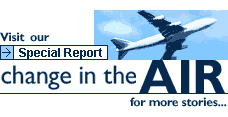 An industry characterized by a mix of meager profits, huge losses and miserly shareholder returns, is rapidly becoming a battle between the alliances that have proliferated among the leading players in the United States, Europe and Asia, say analysts. An industry characterized by a mix of meager profits, huge losses and miserly shareholder returns, is rapidly becoming a battle between the alliances that have proliferated among the leading players in the United States, Europe and Asia, say analysts.
Reports of talks between American Airlines' parent AMR Corp. (AMR: Research, Estimates) and Northwest Airlines (NWAC: Research, Estimates) as well as expectations in the market that Delta Air Lines (DAL: Research, Estimates) would consider making a move for Continental Airlines (CAL: Research, Estimates) have been mirrored in Europe. British Airways (BAY) has admitted it is in merger talks with KLM Royal Dutch Airlines. Such a combination would not only create the world's third-biggest carrier, but would also herald further-reaching changes in the air lanes over Europe.
"There's a very clear map of what might happen in terms of global industry consolidation," said Andrew Lobbenberg, an airline analyst at Fleming Securities in London. "But it is a very uncertain environment: we need to see what happens in the United States."
Three is the crowd
In concert with most industry experts, Lobbenberg believes the future will see the industry dominated by three groupings, representing the dominant players on each continent.
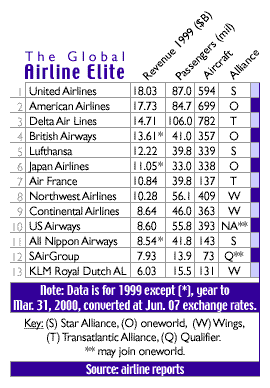
The Star Alliance led by United and Lufthansa (FLHA), the European number two, and featuring 11 partners including Singapore Airlines, Brazil's Varig and Japan's All Nippon Airways, is already the dominant force in this process of consolidation.
"The markets have become global," Ulrich Schulte-Strathaus, Lufthansa's vice-president international affairs, told CNNfn.com, arguing that further consolidation is inevitable. "Alliances have established themselves with a global reach by combining their respective networks."
With combined revenue of $65 billion last year, 2,000 aircraft and the largest global route network carrying 282 million passengers, the Star Alliance aims to provide seamless service by co-ordinating its members' activities. The alliance participants also pool some purchasing to cut costs.
A rival alliance led by American and BA, known as oneworld, is smaller and less developed, but includes Japan Airlines, Cathay Pacific and Australia's Qantas. The current round of deals may bring Northwest and KLM into the oneworld camp: the U.S. airline is at present KLM's partner in an alliance called Wings, but may soon be combined with American, while KLM ties up with British Airways.
The third remaining group is so far made up of only Delta Air Lines and Air France, but has the clout to attract others and gain critical mass for the global dogfight.
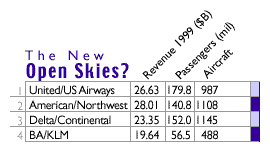
The difference about the latest round of actual and possible deals is that the industry is returning to the pursuit of all-out acquisitions, after a period when looser alliances between financially independent companies was the preferred way of achieving the scale to compete globally.
International rules limiting cross-border deals have typically hindered outright purchases. In many forays into new countries, acquisitive carriers have found their ownership ambitions limited at best to a minority stake in their target company.
The current system whereby airlines' access to overseas routes is governed by a multitude of bilateral agreements between countries is seen as creaky. Under this system, an airline cannot operate international services unless it is majority controlled by investors of the country where it is based. That rule could come under threat from deals such as the agreement in April for Swissair's parent SAirGroup to take control of Belgium' Sabena. SAir aims to place its shares in a Belgian-registered holding company to retain Sabena's existing air travel rights, but the deal is seen as a precursor of more cross-border moves.
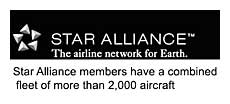 This would at least alleviate some of the pressure on regulators, concerned that the shrinking number of airlines is harming competition and will push up fares. This would at least alleviate some of the pressure on regulators, concerned that the shrinking number of airlines is harming competition and will push up fares.
"I admit that we don't know whether the consolidation is leading (transport) policy or vice versa," conceded a senior transport official at the European Commission in Brussels, which deregulated the European Union's air travel business in 1992 along the same lines as the United States.
"What we do know is that the jury is still out on the anti-competitive impact of alliances, never mind more mergers."
More airborne musical chairs
Analysts have no doubt, however, that the latest M&A moves are good for investors, generating the potential to cut costs, attract more passengers and boost earnings.
The benefits to passengers are harder to define.
The independent airlines that remain a thorn in the side of the majors believe the latest flurry of deals is no different from previous waves of consolidation, with the same effects.
"It's just moving the musical chairs again," said Michael O'Leary, chief executive of Dublin-based Ryanair (RYAAR: Research, Estimates), Europe's largest low-cost carrier, modeled on Southwest Airlines (LUV: Research, Estimates).
"It's all about reducing the level of competition; it will make the fat fatter and it is the customer who gets screwed."
O'Leary, known in the industry for his no-holds barred views and trademark casual dress, is a firm believer that the industry is no different from any other service business, except in the minds of those who run it.
"It's still run by people who always wanted to play with planes rather than make money," says O'Leary.
However, Lufthansa's Schulte-Strathaus contends that fierce competition between the global players has the capacity to drive down prices.
"Studies have shown that alliances have a tendency to penetrate (previously closed) markets and aggressively increase competition. Prices have significantly fallen as a result of competing alliance systems."
But could a new breed of super-carriers run counter to the consumer's interests? Not according to Schulte-Strathaus: "No single carrier, not even United, would be so big on a global scale that it could afford to resort to monopolistic market behaviour."
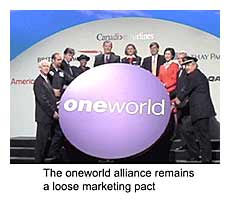 Airline industry veterans can raise only a wry smile when they hear yet again the oldest joke in the business. What's the easiest way to turn a billionaire into a millionaire? Start an airline. Airline industry veterans can raise only a wry smile when they hear yet again the oldest joke in the business. What's the easiest way to turn a billionaire into a millionaire? Start an airline.
Shareholders would find it hard to disagree. This most cyclical of industries is entering its latest downturn, eroding already wafer-thin profits
Global airline earnings fell to $1.9 billion last year from $3.2 billion the year. That's the aggregated profit made by the 238 members of the International Air Transport Association (IATA), the industry's global trade body, and it's forecast to sink again this year.
Total operating profit that amounts to just 1.9 percent of overall revenue represents thin pickings for an industry that carried 1.3 billion passengers last year and is expected to grow at 5 percent a year over the next 20 years.
Addressing IATA's annual general meeting in Sydney on Jun. 6, its director-general Pierre Jeanniot pointed out that average air fares are 70 percent lower in real terms than 20 years ago, a reflection of the adoption of increasingly efficient aircraft and the impact of competition.
Consumers will hope that the latest round of airline marriages continues the trend. 
|
|
|
|
|
 |

|

